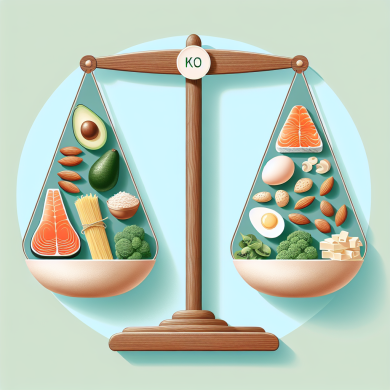Keto vs. Low-Carb: Decoding Dietary Differences
Introduction
The realm of dietary strategies is vast and varied, with many individuals seeking to optimize their health and wellness through nutrition. Among the most discussed and debated diets are the ketogenic (keto) diet and the low-carb diet. Both emphasize reducing carbohydrate intake, yet they differ significantly in their approach and outcomes. Understanding these differences is crucial for anyone considering adopting one of these diets. This article will delve into the nuances of keto and low-carb diets, exploring their core principles, potential benefits, and drawbacks.
Understanding the Ketogenic Diet
Core Principles of Keto
The ketogenic diet is a high-fat, adequate-protein, and very low-carbohydrate diet. Its primary objective is to shift the body’s metabolism from relying on glucose as its main energy source to using ketones, which are produced from the breakdown of fats in the liver. This metabolic state is known as ketosis.
Typically, the macronutrient composition of a keto diet is approximately 70-75% fat, 20-25% protein, and 5-10% carbohydrates. This drastic reduction in carbohydrates is the catalyst for entering ketosis.
Potential Benefits of Keto
Many proponents of the keto diet advocate for its benefits, which include significant weight loss, improved blood sugar control, enhanced mental clarity, and increased energy levels. Additionally, the diet has therapeutic uses in treating conditions like epilepsy, particularly in children. Recent studies also suggest potential benefits for neurological diseases like Alzheimer’s and Parkinson’s.
Drawbacks of Keto
Despite its benefits, the keto diet is not without its challenges. The initial transition can lead to what is known as the “keto flu,” characterized by symptoms such as fatigue, headache, dizziness, and irritability. Long-term adherence can also be challenging due to its restrictive nature, leading to potential nutrient deficiencies if not carefully managed. Moreover, the high fat intake may not be suitable for individuals with certain health conditions, such as pancreatitis or liver disease.
Exploring the Low-Carb Diet
Core Principles of Low-Carb
The low-carb diet is less rigid than the keto diet regarding carbohydrate intake. While there is no universally accepted definition, a low-carb diet typically involves consuming 50-150 grams of carbohydrates per day. This is significantly higher than the keto diet, allowing for more flexibility in food choices.
The macronutrient distribution in a low-carb diet is usually more balanced, with a moderate intake of fats and proteins. This flexibility makes it more sustainable for many people in the long run.
Potential Benefits of Low-Carb
One of the primary advantages of a low-carb diet is its potential for weight loss and improved metabolic health. Reducing carbohydrate intake can lead to lower insulin levels, prompting the body to burn stored fat for energy. This diet may also help stabilize blood sugar levels, making it beneficial for individuals with type 2 diabetes or insulin resistance.
Additionally, the broader range of permitted foods can lead to increased adherence and a more varied nutrient intake, supporting overall health and well-being.
Drawbacks of Low-Carb
While the low-carb diet offers more flexibility, it may not provide the same rapid weight loss or metabolic benefits as the keto diet. Some individuals may not experience the same improvements in mental clarity and energy levels. Furthermore, without careful planning, there is a risk of consuming too much protein or unhealthy fats, which can negate potential health benefits.
Comparing Keto and Low-Carb Diets
Weight Loss
Both the keto and low-carb diets can be effective for weight loss, though they achieve this through different mechanisms. The keto diet’s state of ketosis leads to rapid fat burning and weight loss, particularly in the initial phases. In contrast, the low-carb diet may result in a slower but more sustainable weight loss due to its less restrictive nature.
Metabolic Health
Both diets can improve metabolic health by reducing insulin levels and increasing insulin sensitivity. However, the keto diet may offer more pronounced benefits for individuals with severe insulin resistance or obesity, given its more drastic shift in metabolic state.
Dietary Flexibility and Sustainability
In terms of flexibility, the low-carb diet has the upper hand, allowing for a more varied and less restrictive eating pattern. This can lead to better long-term adherence for many individuals. The keto diet’s restrictiveness can make it challenging to maintain over time, though some people thrive on its structured nature.
Potential Health Risks
Both diets, if not properly managed, can pose health risks. The keto diet’s high-fat content may increase the risk of heart disease if unhealthy fats are consumed. The low-carb diet, while more balanced, can lead to excessive protein intake, potentially impacting kidney health in susceptible individuals.
Who Should Choose Which Diet?
The decision between a keto and low-carb diet should be personalized, taking into account individual health goals, lifestyle, and medical history.
The keto diet may be suitable for individuals seeking rapid weight loss, those with specific neurological conditions, or individuals looking to improve severe insulin resistance. However, it requires careful planning and monitoring to avoid potential health risks.
On the other hand, the low-carb diet is often better suited for those seeking a more balanced approach to weight management and metabolic health. Its flexibility makes it a viable long-term lifestyle change for many people.
Conclusion
In the debate of keto versus low-carb, there is no one-size-fits-all answer. Both diets have their unique advantages and challenges, and the best choice depends on individual preferences and health objectives. It’s important for anyone considering these diets to consult with a healthcare provider or a registered dietitian to ensure the chosen diet aligns with their needs and promotes overall health and well-being.
Ultimately, the key to success with any diet is adherence, balance, and a focus on whole, nutrient-dense foods. By understanding the differences between keto and low-carb diets, individuals can make informed decisions that support their journey towards better health.















Add comment